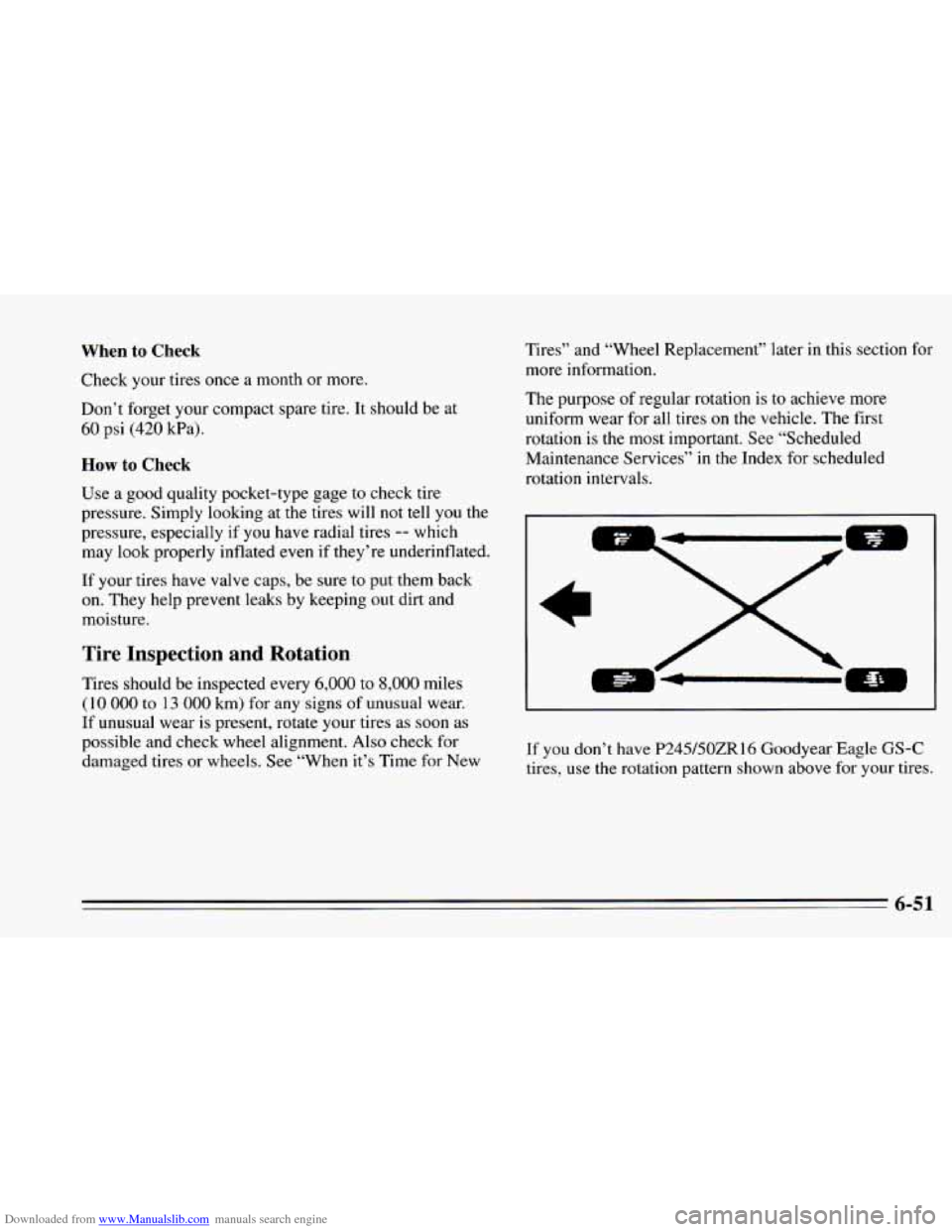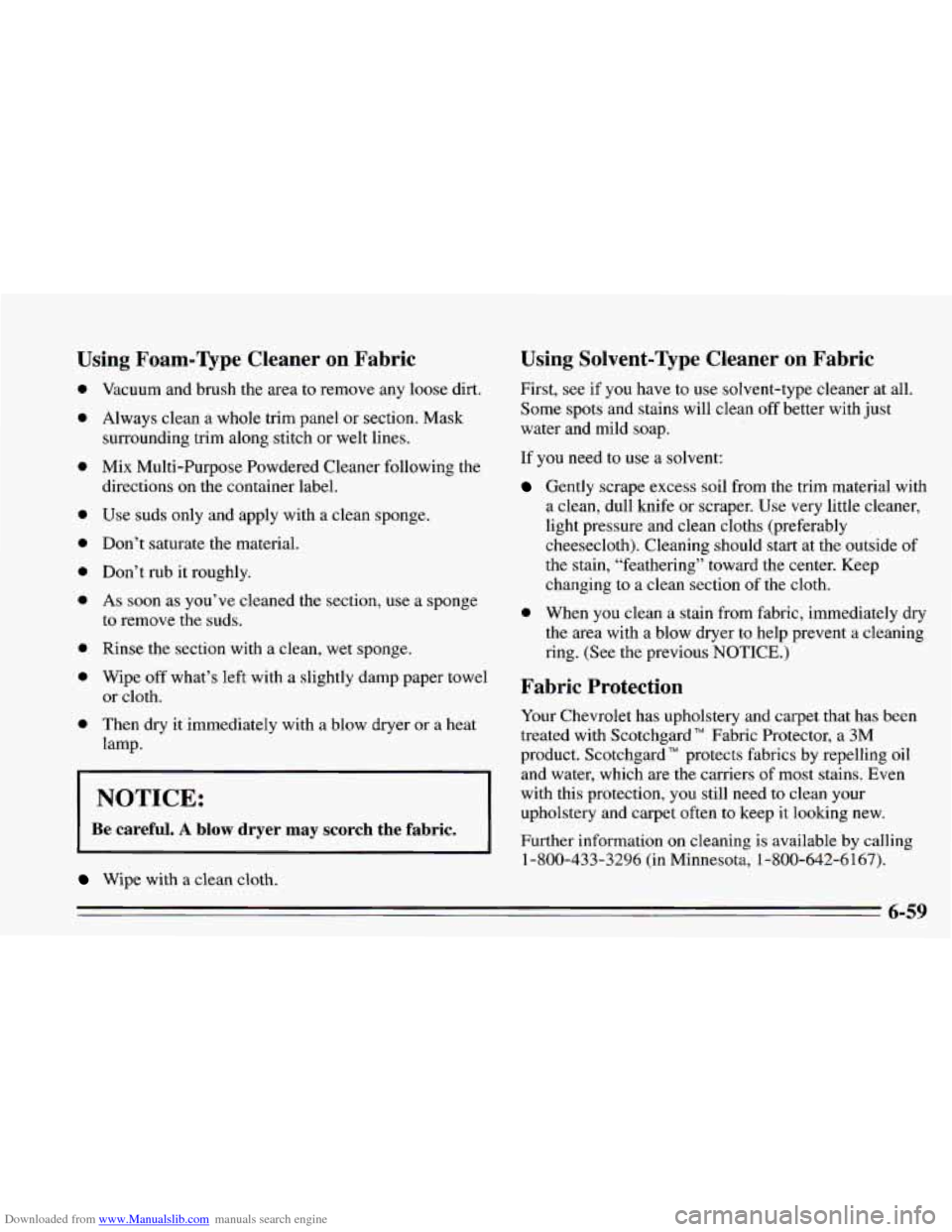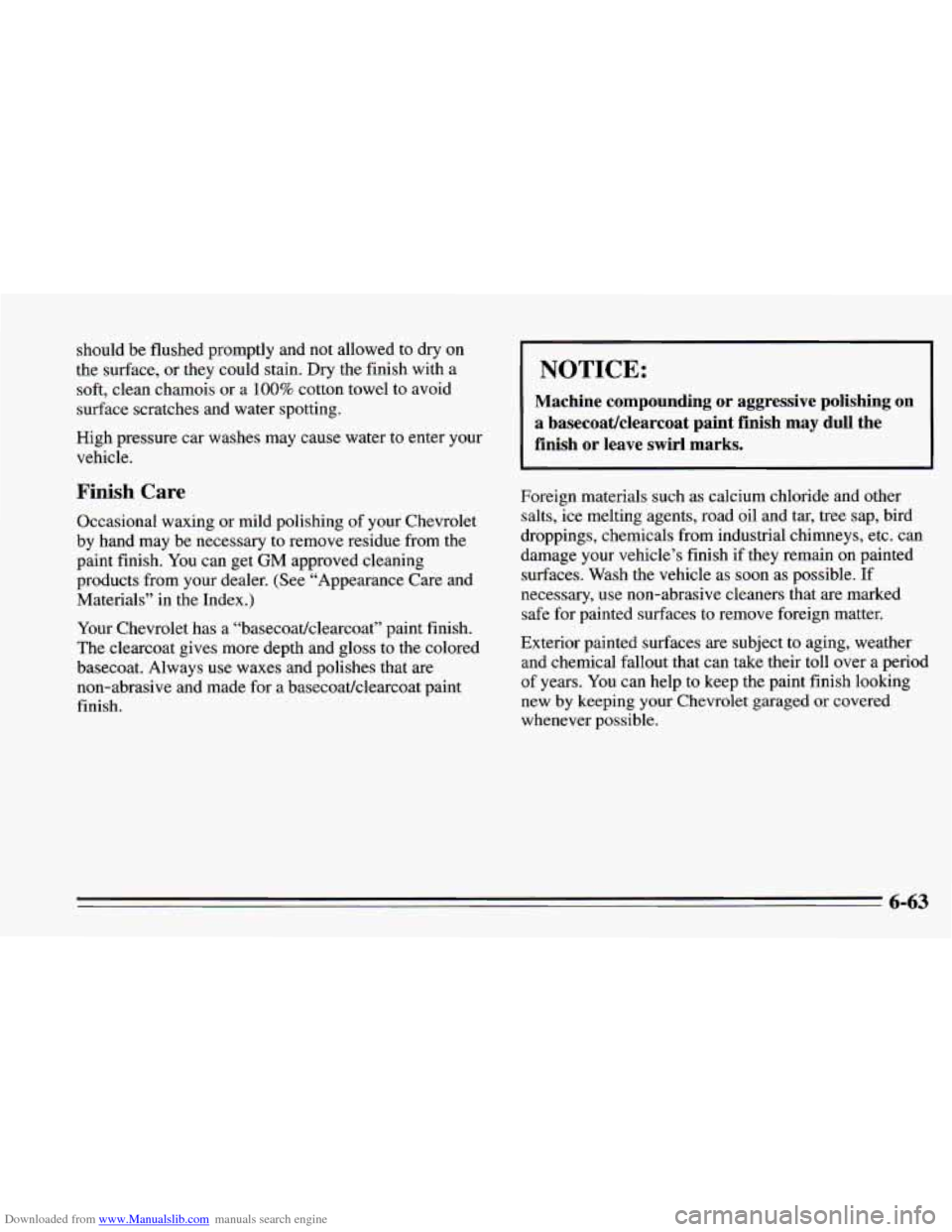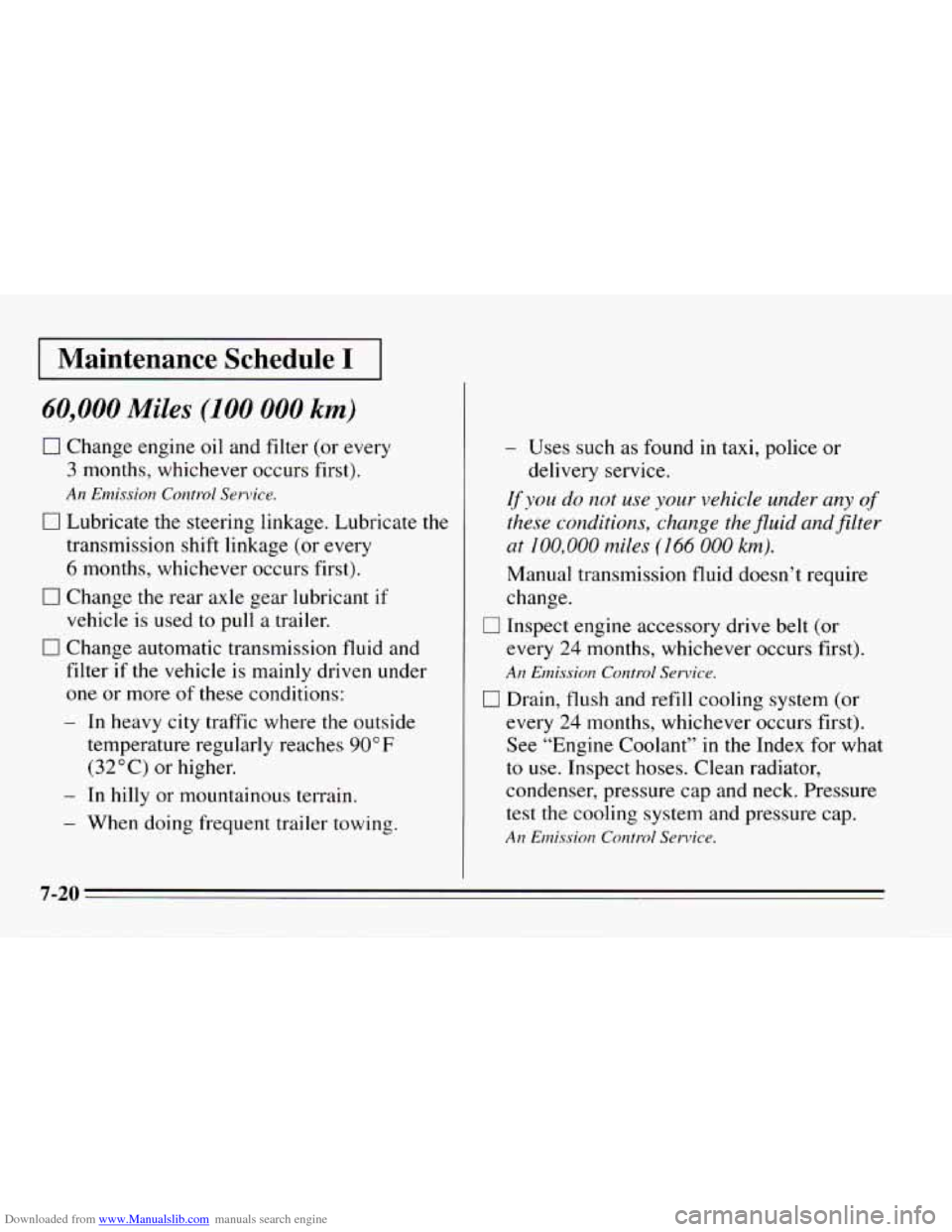Page 283 of 388

Downloaded from www.Manualslib.com manuals search engine When to Check
Check your tires once a month or more.
Don’t forget your compact spare tire. It should be at
60 psi (420 kPa).
DW to Check
use a good quality pocket-type gage to check tire
pressure. Simply looking at the tires will not tell you the
pressure, especially if you have radial tires
-- which
may look properly inflated even if they’re underinflated.
If your tires have valve caps, be sure to put them back
on. They help prevent leaks by keeping out dirt and
moisture.
Tire Inspection and Rotation
Tires should be inspected every 6,000 to 8,000 miles
(1 0 000 to 13 000 km) for any signs of unusual wear.
If unusual wear is present, rotate your tires as soon as
possible and check wheel alignment. Also check for
damaged tires or wheels. See “When it’s Time
for New Tires”
and “Wheel Replacement” later
in this section for
more information.
The purpose
of regular rotation is to achieve more
uniform wear for all tires on the vehicle. The first
rotation
is the most important. See “Scheduled
Maintenance Services”
in the Index for scheduled
rotation intervals.
-7 [*
If you don’t have P245/5OZR16 Goodyear Eagle GS-C
ires, use the rotation pattern shown above for your tires.
6-51
Page 284 of 388
Downloaded from www.Manualslib.com manuals search engine LIJ
If you have P245/50ZR 16 Goodyear Eagle GS-C tires,
they must roll
in a certain direction for the best overall
performance. The direction
is shown by an arrow on
both sidewalls. Because these tires are directional, they
should be rotated as shown here. These tires should only
be moved from front to rear and rear to front on the
same side
of the vehicle. After the
tires
have been rotated, adjust the front and
rear inflation pressures as shown
on the Tire-Loading
Information label.
Make certain that all wheel nuts are
properly tightened. See “Wheel Nut Torque” in the
Index.
Page 291 of 388

Downloaded from www.Manualslib.com manuals search engine Using Foam-Type Cleaner on Fabric
0
0
0
0
0
0
0
0
0
0
Vacuum and brush the area to remove any loose dirt.
Always clean a whole trim panel or section. Mask
surrounding trim along stitch or welt lines.
Mix Multi-Purpose Powdered Cleaner following the
directions on the container label.
Use suds only and apply with a clean sponge.
Don’t saturate the material.
Don’t rub it roughly.
As soon as you’ve cleaned the section, use a sponge
to remove the suds.
Rinse the section with a clean, wet sponge.
Wipe
off what’s left with a slightly damp paper towel
or cloth.
Then dry it immediately with a blow dryer or a heat
lamp.
~~~
NOTICE:
Be careful. A blow dryer may scorch the fabric.
Wipe with a clean cloth.
Using Solvent-Qpe Cleaner on Fabric
First, see if you have to use solvent-type cleaner at all.
Some spots and stains will clean off better with just
water and mild soap.
If you need to use a solvent:
Gently scrape excess soil from the trim material with
a clean, dull knife or scraper. Use very little cleaner,
light pressure and clean cloths (preferably
cheesecloth). Cleaning should start at the outside of
the stain, “feathering” toward the center. Keep
changing to
a clean section of the cloth.
0 When you clean a stain from fabric, immediately dry
the area with a blow dryer to help prevent a cleaning
ring. (See the previous NOTICE.)
Fabric Protection
Your Chevrolet has upholstery and carpet that has been
treated with Scotchgard” Fabric Protector,
a 3M
product. Scotchgard
TM protects fabrics by repelling oil
and water, which are the carriers of most stains. Even
with this protection, you still need to clean your
upholstery and carpet often to keep it looking new.
Further information on cleaning is available by calling
1-800-433-3296 (in Minnesota, 1-800-642-6167).
6-59
Page 295 of 388

Downloaded from www.Manualslib.com manuals search engine should be flushed promptly and not allowed to dry on
the surface, or they could stain.
Dry the finish with a
soft, clean chamois or a
100% cotton towel to avoid
surface scratches and water spotting.
High pressure car washes may cause water to enter your
vehicle.
Finish Care
Occasional waxing or mild polishing of your Chevrolet
by hand may be necessary to remove residue from the
paint finish. You can get
GM approved cleaning
products from your dealer. (See “Appearance Care and
Materials” in the Index.)
Your Chevrolet has a “basecoatklearcoat” paint finish.
The clearcoat gives more depth and gloss to
the colored
basecoat. Always use waxes and polishes that are
non-abrasive and made for a basecoatlclearcoat paint
finish.
I NOTICE:
Machine compounding or aggressive polishing on
a basecoatlclearcoat paint finish may dull the
finish or leave swirl marks.
Foreign materials such as calcium chloride and other
salts, ice melting agents, road oil and tar, tree sap, bird
droppings, chemicals from industrial chimneys, etc. can
damage your vehicle’s finish if they remain on painted
surfaces. Wash the vehicle as soon as possible. If
necessary, use non-abrasive cleaners that are marked
safe
for painted surfaces to remove foreign matter.
Exterior painted surfaces are subject to aging, weather
and chemical fallout that can take their toll over
a period
of years.
You can help to keep the paint finish looking
new
by keeping your Chevrolet garaged or covered
whenever possible.
6-63
Page 320 of 388
Downloaded from www.Manualslib.com manuals search engine I Maintenance Schedule I I
27,000 Miles (45 000 km)
0 Change engine oil and filter (or every
3 months, whichever occurs first).
An Emission Control Service.
30,000 Miles (50 000 km)
0 Change engine oil and filter (or every
3 months, whichever occurs first).
An Emission Control Sewice.
0 Lubricate the steering linkage. Lubricate the
transmission shift linkage (or every
6 months, whichever occurs first).
0 Change the rear axle gear lubricant if
vehicle is used to pull a trailer.
Inspect engine accessory drive belt (or
every
24 months, whichever occurs first).
An Emission Control Service
0 Drain, flush and refill cooling system (or
every
24 months, whichever occurs first).
See “Engine Coolant” in the Index for what
to use. Inspect hoses. Clean radiator,
condenser, pressure cap and neck. Pressure
test the cooling system and pressure cap.
An Emission Control Service.
7-12
Page 328 of 388

Downloaded from www.Manualslib.com manuals search engine Maintenance Schedule I
60,000 Miles (100 000 km)
0 Change engine oil and filter (or every
3 months, whichever occurs first).
An Emission Control Service.
0 Lubricate the steering linkage. Lubricate the
transmission shift linkage (or every
6 months, whichever occurs first).
0 Change the rear axle gear lubricant if
vehicle is used to pull a trailer.
0 Change automatic transmission fluid and
filter
if the vehicle is mainly driven under
one or more
of these conditions:
- In heavy city traffic where the outside
temperature regularly reaches
90 OF
(32°C) or higher.
- In hilly or mountainous terrain.
- When doing frequent trailer towing.
- Uses such as found in taxi, police or
Ifyou do not use your vehicle under any of
these conditions, change the fluid and filter
at 100,000 miles (I 66 000 km).
Manual transmission fluid doesn’t require
change.
every 24 months, whichever occurs first).
c] Drain, flush and refill cooling system (or
every 24 months, whichever occurs first).
See “Engine Coolant”
in the Index for what
to
use. Inspect hoses. Clean radiator,
condenser, pressure cap and neck. Pressure
test the cooling system and pressure cap.
delivery service.
0 Inspect
engine accessory drive belt (or
An E1nissi01.1 Control Service.
An Elnissiorz Control Service.
7-20
Page 336 of 388

Downloaded from www.Manualslib.com manuals search engine -
Maintenance Schedule I
90,000 Miles (150 000 km) (Continued)
- Uses such as found in taxi, police or
If you do not use your vehicle under any of
these conditions, change the fluid and filter
at
lO0,OOO miles (166 000 km).
Manual transmission fluid doesn’t require
change.
every
24 months, whichever occurs first).
An Emission Control Service.
0 Drain, flush and refill cooling system (or
every
24 months, whichever occurs first).
See “Engine Coolant” in the Index for what
to use. Inspect hoses. Clean radiator,
condenser, pressure cap and neck. Pressure
test the cooling system and pressure cap.
An Emission Control Service.
Replace spark plugs (except 5.7L Code P
delivery service.
0 Inspect engine accessory drive belt (or
engine).
An Emission Control Service.
0 In SP ect sp
Service.
arle Pl .ug wires. An Emission Control
0 Replace air cleaner filter. Replace filter
more often under dusty conditions.
An Emission Control Service.
0 Inspect fuel tank, cap and lines for damage
or leaks. Inspect fuel cap gasket for any
damage. Replace parts as needed.
El Rotate tires. See “Tire Inspection and
Rotation”
in the Index for proper rotation
pattern and additional information.
An Emission Control Service.
Page 343 of 388

Downloaded from www.Manualslib.com manuals search engine Maintenance Schedule I1
- Uses such as found in taxi, police or
If you do not use your vehicle under any of
these conditions, change the fluid and filter
at 100,000 miles (1 66 000 km).
Manual transmission fluid doesn’t require
change.
every
24 months, whichever occurs first).
0 Drain, flush and refill cooling system (or every
24 months, whichever occurs first).
See “Engine Coolant’’ in the Index for what
to use. Inspect hoses. Clean radiator,
condenser, pressure cap and neck. Pressure
test the cooling system and pressure cap.
An Emission Control Service.
delivery service.
Inspect engine accessory drive belt (or
An Emission Control Service.
0 Replace spark plugs (except 5.7L Code P
0 Inspect spark plug wires. An Emission Control
0 Replace air cleaner filter. An Emission Control
0 Inspect fuel tank, cap and lines for damage
or leaks. Inspect fuel cap gasket for any
damage. Replace
parts as needed.
engine).
An
Emission Control Service.
Service.
Service.
An Emission Control Sewice.
7-35